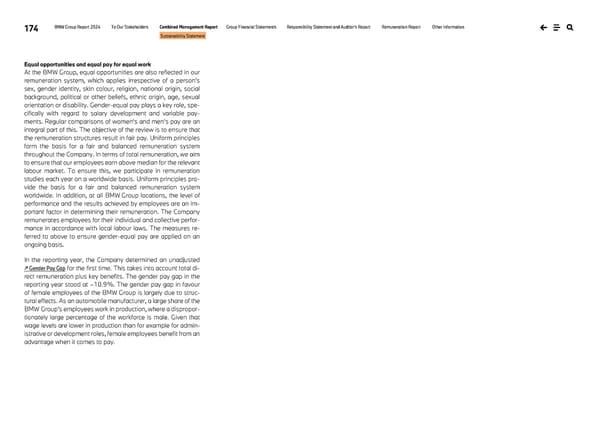174 BMW Group Report 2024 To Our Stakeholders Combined Management Report Group Financial Statements Responsibility Statement and Auditor’s Report Remuneration Report Other Information Sustainability Statement Equal opportunities and equal pay for equal work At the BMW Group, equal opportunities are also reflected in our remuneration system, which applies irrespective of a person’s sex, gender identity, skin colour, religion, national origin, social background, political or other beliefs, ethnic origin, age, sexual orientation or disability. Gender-equal pay plays a key role, spe- cifically with regard to salary development and variable pay- ments. Regular comparisons of women’s and men’s pay are an integral part of this. The objective of the review is to ensure that the remuneration structures result in fair pay. Uniform principles form the basis for a fair and balanced remuneration system throughout the Company. In terms of total remuneration, we aim to ensure that our employees earn above median for the relevant labour market. To ensure this, we participate in remuneration studies each year on a worldwide basis. Uniform principles pro- vide the basis for a fair and balanced remuneration system worldwide. In addition, at all BMW Group locations, the level of performance and the results achieved by employees are an im- portant factor in determining their remuneration. The Company remunerates employees for their individual and collective perfor- mance in accordance with local labour laws. The measures re- ferred to above to ensure gender-equal pay are applied on an ongoing basis. In the reporting year, the Company determined an unadjusted ↗ Gender Pay Gap for the first time. This takes into account total di- rect remuneration plus key benefits. The gender pay gap in the reporting year stood at –10.9%. The gender pay gap in favour of female employees of the BMW Group is largely due to struc- tural effects. As an automobile manufacturer, a large share of the BMW Group's employees work in production, where a dispropor- tionately large percentage of the workforce is male. Given that wage levels are lower in production than for example for admin- istrative or development roles, female employees benefit from an advantage when it comes to pay.
 BMW Group Report 2024 Page 173 Page 175
BMW Group Report 2024 Page 173 Page 175